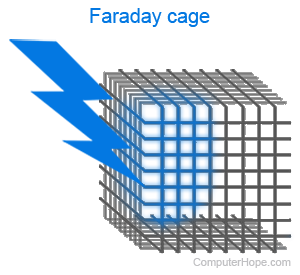Faraday cage
Updated: 10/11/2021 by Computer Hope

Invented by Michael Faraday in 1836, a Faraday cage is a mesh made of conductive material that protects anything inside from electric currents and electromagnetic fields. A variation of this, known as a Faraday shield, is based on the same concept but contains no gaps. Faraday cages and Faraday shields ensure that radiation and external electric currents do not interfere with delicate electronic devices while testing and using them. They also protect people in dangerous occupations like power line maintenance.
What are Faraday cages and shields used for?
- Microwaves use Faraday cages to prevent the radiation inside from leaking out.
- The metal structures of vehicles, like cars and airplanes, act as Faraday cages during a lightning strike or other dangerous electrical problem.
- Coaxial cables are insulated with conductors, like copper, to prevent interference.
- MRI machines use Faraday shields on the outside to prevent external radiation from showing in the scan results.
- Versions of Faraday cages called Faraday bags are used in criminal justice to protect electronic devices used as evidence from being tampered with remotely.
Electronics terms, ESD, Farad, Hardware terms, Lightning, Power terms
